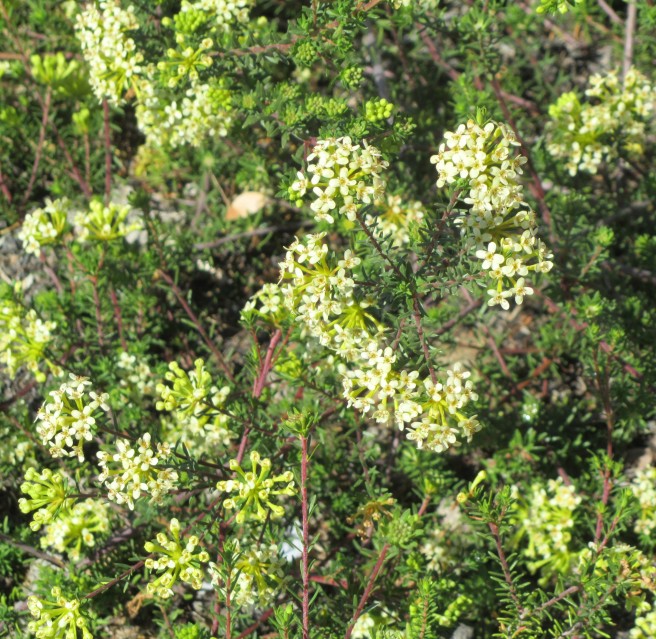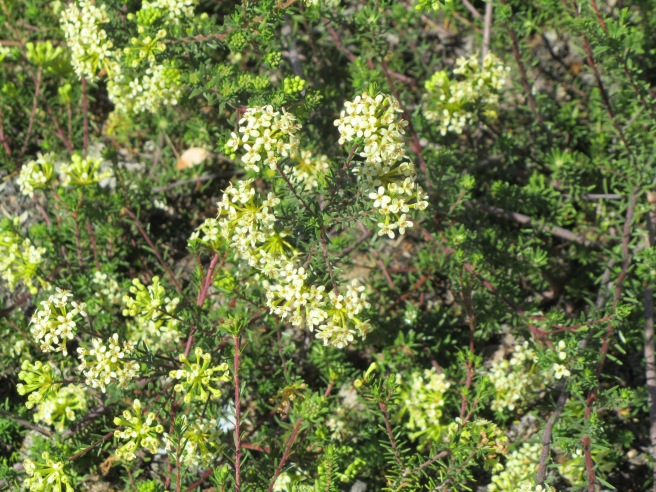Family: Thymelaeaceae (fibre-bark/gonna family)
Common names: aandbossie, juffertjie-roer-by-die nag (Afr.)
Gnidia squarrosa has attractive, multicoloured winter-spring flowers that will fill your garden with perfume in the evenings.
Description
Gnidia squarrosa is a much-branched, lax, willowy shrub that reaches a height of 1 to 2 m, with roughly equal spread. The leaves are small and narrowly lance-shaped. The flowers are borne in rounded heads of 6 – 30 flowers at the tips of the slender branches. The flower consists of a long tube topped by a 4-pointed star, with 8 tiny finger-like petals . The tubes are mostly greenish yellow, the face of the star is creamy white and the flowers are flushed with maroon-pink, but the degree of pink varies from flowerhead to flowerhead on the same bush. On one end of the scale some heads are almost completely greenish yellow with only a stripe of colour on the back and tip of the stars, while on the other end the base of the tubes are deep maroon and most of the flowers are stained pink, and many are somewhere in between, with only a few of the flowers unevenly stained pink. Overall, they give an attractive multi-coloured effect. The flowers are sweetly fragrant at night but unscented during the day, and adorn the bush in winter to spring (June to October). While not a candidate for the commercial trade, they make a good cutflower, lasting a few days in the vase. 
Distribution
Gnidia squarrosa is found from the Cape Peninsula to the Eastern Cape and KwaZulu-Natal, where it grows in coastal limestone soils and on sandy slopes.
Ecology
The tubular flower, its pale colour and its strong night fragrance indicate that this species is pollinated by moths.
Derivation of the name
The genus Gnidia was named by Linnaeus, but it is not clear where it came from or why he chose it. It is perhaps a Greek word for Daphne or laurel, or it is possibly derived from the old Greek name for Knossos in Crete, Knidiossos was one version. Both common names are Afrikaans, aandbossie means ‘night or evening-scented bush’, and juffertjie-roer-by-die-nag means literally ‘young-lady-gad-about-at-night’. Both are generic names given to many plants with night-scented flowers, and the latter name is more strictly used for Struthiola species.
Gnidia squarrosa is an easy plant in the garden, particularly fynbos and coastal gardens. It does best in full sun and well-drained soil, and will need some room to spread. Remember to treat it like a fynbos plant, i.e. put it in a well-drained, sunny spot and don’t give it manure or heavy doses of chemical fertilizers, and it will thrive. Plant it where you can appreciate its beautiful night scent, e.g. near the house, or beside the patio or a path that you use in the evenings.


Fragrant flowers always get my vote, Aletta!
Thanks for taking part in the Floral Friday Fotos meme. I look forward to your contribution this week.
LikeLiked by 1 person
Thank you!
LikeLike
Wow wonderful colors and flowers. I love the spring flowers.
LikeLiked by 1 person
Thank you! Yes they are beautiful!
LikeLike
beautiful tiny flowers, Aletta! thanks for the info. 🙂
LikeLiked by 1 person
I am glad you liked it, Lola!
LikeLike
Superb captures along with great info
LikeLiked by 1 person
Thank you so much Hammad!
LikeLiked by 1 person
How beautiful, and so sunny. 🙂
LikeLiked by 1 person
Thank you, Sylvia!
LikeLiked by 1 person
I can almost smell them. I bet they are amazing.
LikeLiked by 1 person
They are indeed!
LikeLike
a million little stars
LikeLiked by 1 person
Thank you, Tom!
LikeLike